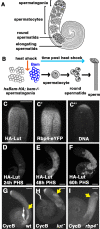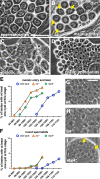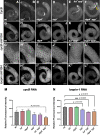Cell-type-specific interacting proteins collaborate to regulate the timing of Cyclin B protein expression in male meiotic prophase
- PMID: 37882771
- PMCID: PMC10730016
- DOI: 10.1242/dev.201709
Cell-type-specific interacting proteins collaborate to regulate the timing of Cyclin B protein expression in male meiotic prophase
Abstract
During meiosis, germ cell and stage-specific components impose additional layers of regulation on the core cell cycle machinery to set up an extended G2 period termed meiotic prophase. In Drosophila males, meiotic prophase lasts 3.5 days, during which spermatocytes upregulate over 1800 genes and grow 25-fold. Previous work has shown that the cell cycle regulator Cyclin B (CycB) is subject to translational repression in immature spermatocytes, mediated by the RNA-binding protein Rbp4 and its partner Fest. Here, we show that the spermatocyte-specific protein Lut is required for translational repression of cycB in an 8-h window just before spermatocytes are fully mature. In males mutant for rbp4 or lut, spermatocytes enter and exit meiotic division 6-8 h earlier than in wild type. In addition, spermatocyte-specific isoforms of Syncrip (Syp) are required for expression of CycB protein in mature spermatocytes and normal entry into the meiotic divisions. Lut and Syp interact with Fest independent of RNA. Thus, a set of spermatocyte-specific regulators choreograph the timing of expression of CycB protein during male meiotic prophase.
Keywords: Drosophila; Cyclin B; Meiosis; RNA; Spermatogenesis; Translation.
© 2023. Published by The Company of Biologists Ltd.
Conflict of interest statement
Competing interests The authors declare no competing or financial interests.
Figures










Update of
-
A cell-type-specific multi-protein complex regulates expression of Cyclin B protein in Drosophila male meiotic prophase.bioRxiv [Preprint]. 2023 Feb 17:2023.02.16.528869. doi: 10.1101/2023.02.16.528869. bioRxiv. 2023. Update in: Development. 2023 Nov 15;150(22):dev201709. doi: 10.1242/dev.201709. PMID: 36824933 Free PMC article. Updated. Preprint.
References
-
- Arvola, R. M., Chang, C.-T., Buytendorp, J. P., Levdansky, Y., Valkov, E., Freddolino, P. L. and Goldstrohm, A. C. (2020). Unique repression domains of Pumilio utilize deadenylation and decapping factors to accelerate destruction of target mRNAs. Nucleic Acids Res. 48, 1843-1871. 10.1093/nar/gkz1187 - DOI - PMC - PubMed
Publication types
MeSH terms
Substances
Grants and funding
LinkOut - more resources
Full Text Sources
Molecular Biology Databases
Miscellaneous

